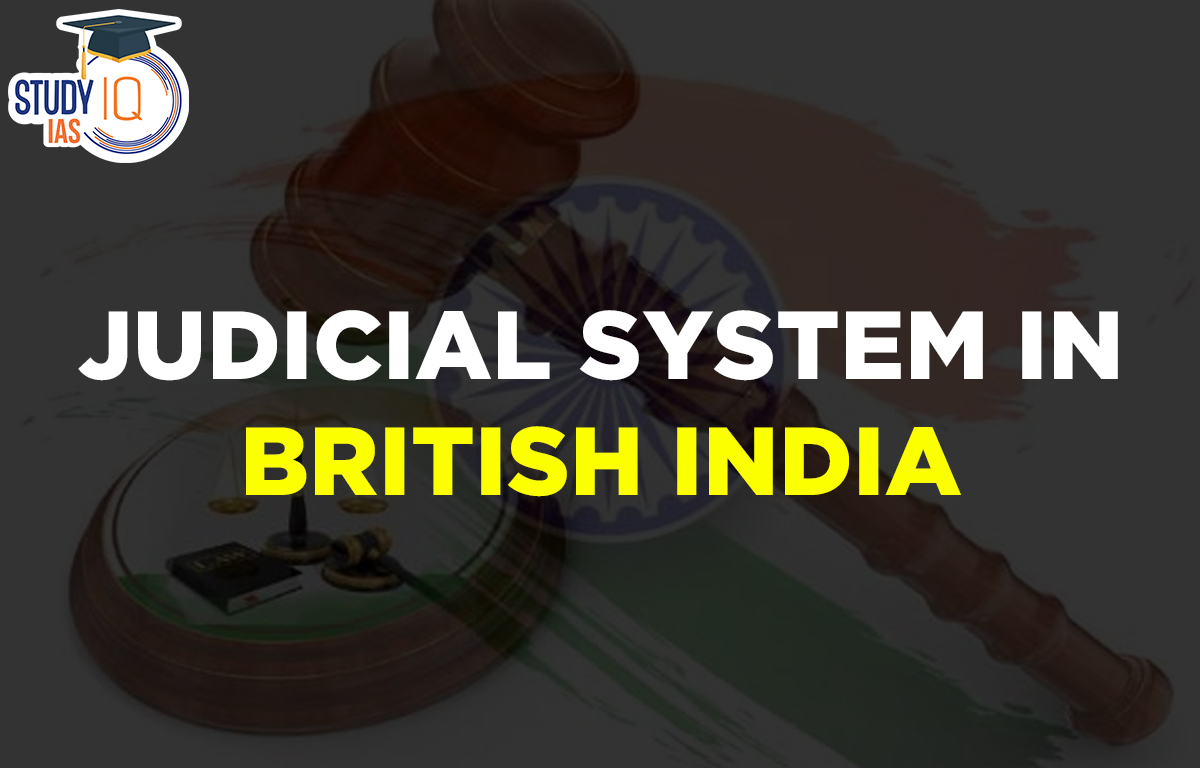Table of Contents
Judicial System in British India
A common law system based on documented court precedents was first established by the East India Company in Madras, Bombay, and Calcutta in the year 1726. The Mughal legal system was replaced when the Company transitioned from a commercial company to a governing force, adding new components. This post will examine Judicial System in British India and significant judicial reforms that were implemented, which will be beneficial for UPSC exam preparation.
Judicial System in British India History
The pre-colonial Indian judicial system, whether during the Mughal era or even earlier (during the ancient period), did not adopt proper procedures, organise the law courts in a regular grading from the highest to the lowest, or distribute the courts proportionately to the areas they would be serving. Most Hindu court cases were determined by zamindars, local panchayats, or elders of the caste.
The unit of judicial administration for Muslims was the qazi, an office held by religious individuals, which was situated in provincial capitals, towns, and qasbas (large villages). As the purveyors of justice, the rajas and badshahs, the administration of justice may be arbitrary.
Judicial System in British India Reforms
1. Reforms under Warren Hastings
District Diwani Adalats, presided over by a collector, were established to handle civil disputes involving both Muslim and Hindu law. The District Diwani Adalats’ appeal was heard by the Sadar Diwani Adalat. To handle criminal cases, District Fauzdari Adalats were established. They were managed by an Indian officer with the aid of qazis and muftis. The collector also had overall control over these adalats. Fauzdari Adalats were employed to enforce Islamic law.
Capital punishment and property acquisition were handled by the Sadar Nizamat Adalat in Murshidabad, which was led by a deputy Nizam (an Indian Muslim) and assisted by the main qazi and senior mufti. The Regulating Act of 1773 established a Supreme Court in Calcutta with the power to hear cases involving all British subjects living in Calcutta and its associated factories, including Indians and Europeans. It was an appellate and original jurisdictional court.
2. Reforms under Cornwallis
Warren Hastings was succeeded as Governor-General by Lord Cornwallis in 1786. He implemented judicial changes in the years 1787, 1790, and 1793. These changes were known as the Judicial Plan of 1787, 1790, and 1793.
3. Reforms under William Bentinck
During the administration of Governor-General William Bentinck, the four Circuit Courts were abolished. Their duties were given to the Collector, who was in charge of them under the direction of the commissioner of revenue and circuit. At Allahabad, William Bentinck erected Sadar Diwani Adalat and Sadar Nizamat Adalat for the comfort of the residents of the upper provinces.
The court’s official language in the past was Persian. The court sessions could now be held in Persian or a local language, nevertheless. The Supreme Court currently conducts all of its hearings in English.
Development of Judicial System in British India
1. Judicial Plan of 1787
The tax and judicial systems were combined under the 1787 Judicial Plan, which gave the Collector control over both. The Collector, an English serf, was given the power to levy taxes and resolve tax-related issues. The number of districts in Bengal, Bihar, and Orissa was reduced from 36 to 23 in order to streamline the tax administration.
Lord Cornwallis built Mal Adalats in each location. These courts dealt only with matters pertaining to income. The court was presided over by the Collector, who was in charge of revenue concerns. The appeals from these revenue tribunals were considered by the Board of Tax in Calcutta and then by the Governor-General in Council.
Additionally, District Diwani Adalats, which dealt with civil disputes, were presided over by the Collector. A new office of the Registrar, commonly referred to as the Registrar court, was established as a subordinate office to the Collector to handle minor civil disputes. The Collector’s signature was necessary before the Registrar’s order became effective.
2. Judicial Plan of 1790
In 1790, Lord Cornwallis made changes to the manner criminal justice was carried out. He reorganised four divisions: Calcutta, Dacca, Murshidabad, and Patna. Circuit Courts took their place after the District Fauzdari Courts were abolished. European judges presided over the circuit courts that were formed in Calcutta, Murshidabad, Dacca, and Patna.
Both civil and criminal appeals are heard by these courts. The Governor-General and members of his council oversaw the relocation of the Sadar Nizamat Adalat, the highest court of criminal appeal, to Calcutta.
3. Judicial Plan of 1793
In 1793, Lord Cornwallis kept advancing the legal system. Mal Adalats, in which Collectors served as judges and ruled over only tax-related issues, were no longer in operation. The District Diwani Adalats received the authority and cases that were still outstanding in these revenue courts.
The Cornwallis Code of 1793 drew a distinct distinction between judicial and revenue management. The Collector was now solely in charge of managing the collection of taxes and lacked any judicial authority. After the District Diwani Adalat, the District, City, or Zilla Court was renamed. To oversee District courts and exercise magisterial authority, the District Judge’s office was established.
A gradation of civil courts was created for both Hindu and Muslim law, and it is as follows:
- The Registrar’s Court is presided over by a European Judge, while the Munsiff’s Court was presided over by Indian authorities.
- The District Court is presided over by the District Judge.
- Four circuit courts make up the provincial courts of appeal.
- The Sadar Diwani Adalat in Calcutta.
- The King-in-Council must be consulted for appeals of 5,000 pounds or more..
The following guidelines were set by the Cornwallis Code:
Government officials were held accountable in civil courts for activities performed while acting in their official position, the administration of revenue and justice were separated, and the notion of the sovereignty of law was established.
Judicial System in British India Charter Act of 1833
The Charter Act of 1833 created the Indian Law Commission, which Lord Macaulay presided over, to compile Indian laws. In response to the law commission’s recommendations, the Code of Civil Procedure (1859), the Indian Penal Code (1860), and the Criminal Procedure Code (1862) were all created.
Judicial System in British India Development
1. Establishment of High Courts
From 1834 until 1861, India’s two sets of courts were in charge of administering justice. The Sadar Adalats and the Supreme Court are two separate courts with their own authorities.
The British government’s next step was to impose uniformity in the administration of justice, which was accomplished in 1861. This came after the Code of Civil Procedure, the Indian Penal Code, and the Criminal Procedure Code were passed in 1859, 1860, and 1861, respectively.
2. The Indian High Court Act of 1861
In August 1861, the British government passed the Indian High Court Act. The Act established three High Courts, one each in the presidencies of Bombay, Madras, and Calcutta. The Sadar Adalats and Supreme Courts of the three presidencies were intended to be unified by this act. The Act thus eliminated the Supreme Court and the Sadar Adalats in Calcutta, Bombay, and Madras, and each of these presidencies was changed to a High Court.
Each High Court consists of a Chief Justice and up to 15 regular justices. The charters for the High Courts of Bombay and Madras were issued in June 1862, while the charter for the High Court of Calcutta was issued in May 1862. As a result, the Calcutta High Court was established as the first High Court in the nation.
The Indian High Court Act of 1861, which permitted the Crown to establish any other High Court inside British India, allowed for the establishment of the High Court for the North-Western Province at Agra in March 1866, replacing the Sadar Adalat. In 1869, this High Court moved to Allahabad. Thus, the Allahabad High Court became the first provincial High Court in the nation.
Following then, more High Courts were created. In February 1916, the Patna High Court was created. The Punjab High Court was established in Lahore in 1919, moved to Shimla upon independence, and subsequently to Chandigarh in 1955.
3. India’s Federal Court and Supreme Court
The Federal Court, which had the authority to settle federal issues between administrations, was formed by the Government of India Act of 1935. The Federal Court was formed in Delhi in 1937, consisting of no more than six judges and a Chief Justice.
In three areas—original, appellate, and advisory—the court possessed jurisdiction. It was established exclusively to settle conflicts between provinces and federal states and to hear limited appeals from the High Courts. In accordance with its advising authority, it provides the governor-general of India with a recommended opinion.
If the Federal Court files an appeal, it may be heard by the Judicial Committee of the Privy Council in London. The federal court was renamed the Supreme Court of India after India gained independence. In order to abolish Privy Council jurisdictions, the Constituent Assembly passed the Abolition of Privy Council Jurisdiction Act in 1949.
On January 28, 1950, the Supreme Court was founded to take the place of the Judicial Committee of the Privy Council and the Federal Court of India. The Supreme Court became the highest court in the Indian legal system as a result.
Judicial System in British India Evolution
1. Positive Aspects
A legal system was developed. The personal and religious laws of the monarchs were supplanted with codified laws. Even European citizens were placed within the jurisdiction, but only European judges could hear criminal cases. Government employees are now liable in civil courts.
2. Negative Aspects
The legal system became more intricate and expensive. Wealthy people have the power to influence the system. There was much opportunity for trickery, fraud, and deception. Long-running legal proceedings meant that justice was delayed. The courts grew overworked as litigation rose. European judges frequently lacked knowledge of Indian traditions and customs.
Judicial System in British India UPSC
We can claim that Indian law was initially influenced by custom and religious texts, which later gave way to common law and secular legal frameworks. It is important to note that the ruling classes had a significant impact on how the Indian judiciary developed over time. For instance, from the arbitration of the Delhi Sultanate through the arbitration of the Mughals to the autocratic arbitration of the English (British).


 Nagari Pracharini Sabha Revival: Backgro...
Nagari Pracharini Sabha Revival: Backgro...
 Ryotwari System in India, Features, Impa...
Ryotwari System in India, Features, Impa...
 Battle of Plassey, History, Causes, Impa...
Battle of Plassey, History, Causes, Impa...





















